During a service writer’s efforts to sell competitive brake services, he or she often focuses on selling “good, better or best” brake friction replacements, while ignoring the added expense of repairing brake hydraulics.
Unfortunately, neglected brake hydraulic systems can cause an expensive warranty comeback or, even worse, a serious traffic accident. In any case, it’s important to advise a potential customer of the importance of servicing and repairing worn brake hydraulics.
It’s not hard for service writers to evaluate the general condition of brake hydraulics without assigning a technician to remove the wheels.
To illustrate, the brake fluid on a vehicle that’s rarely driven will highly likely be contaminated with moisture and normal atmospheric pollution will likely have deteriorated the vehicle’s rubber hoses, caliper seals and wheel cylinder boots beyond normal safety margins.
High humidity climates are also more destructive to brake fluid than arid climates because DOT 3 and DOT 4 brake fluids are hygroscopic, which means that these brake fluids attract atmospheric moisture. The contaminated fluid then corrodes the cylinder bores in master cylinders, brake calipers and wheel cylinders.
While DOT 5 silicone-based brake fluids don’t attract moisture, DOT 5 fluid isn’t used in anti-lock braking systems because of its tendency to foam when the ABS activates (Photo 1).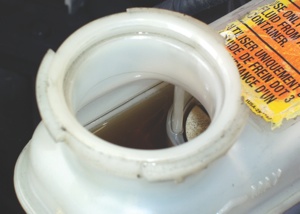
Mileage is also an essential criterion for evaluating the condition of brake hydraulics. Keep in mind that, each time the brakes are applied, the master and wheel cylinder piston seals wear. Given time, the rubber cups in master cylinders wear to the point that they will not consistently seal hydraulic pressure. The result will often be a low brake pedal, poor stopping power or an intermittently sinking brake pedal.
Wheel cylinder cups and caliper piston seals will also begin to externally leak fluid when they wear out. Assuming normal maintenance and operating conditions, master cylinder, wheel cylinder and caliper seals generally begin to leak after the vehicle rolls past the 100,000-mile mark.
System Configurations
Always determine the hardware configuration of the brake hydraulics before recommending an inspection, diagnosis or service. If the vehicle has an orange “ABS” warning light on the instrument panel, it’s equipped with an ABS system (Photo 2).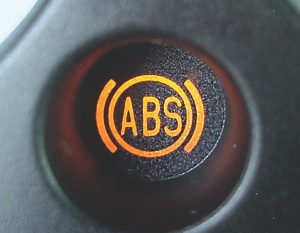
If not, it’s likely to be a 1990s, pre-ABS system that incorporates a combination valve that includes a red brake hydraulic failure warning light, a front disc brake metering valve that delays application of the front disc brakes and a rear brake proportioning valve that limits hydraulic pressure to the rear drum brakes.
The hydraulic system warning light indicates a hydraulic failure in either the front or rear hydraulic systems or, in the case of a dual-diagonal system, in the left-front, right-rear or right-front, left-rear hydraulic systems. In either case, a red ‘brake’ warning light will illuminate (Photo 3). 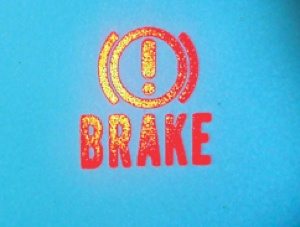
The front disc brake metering valve allows the rear drum brakes to apply before the front disc brakes. Remember, however, that metering valves can’t be used on dual/diagonal systems. The proportioning valve limits pressure to the rear drum brakes to prevent them from locking up during panic stops.
Some light pickup trucks also incorporate a rear brake-metering valve that modulates rear brake hydraulic pressure according to rear suspension height. This valve increases hydraulic pressure at lower suspension heights (loaded condition) and reduces it at higher suspension heights (unloaded con- ditions).
These metering systems were not perfectly engineered when new. In some cases, auto manufacturers attempted to reduce rear drum brake lock-up by installing brake shoes with less frictional area or less frictional coefficient. ABS has, in most cases, functionally replaced the less-than-perfect combination/metering valve hardware configurations.
Cylinder Inspection
The very first step in any brake inspection is to investigate an orange illuminated ‘ABS’ or red ‘brake’ light by attaching a scan tool and retrieving the associated DTCs. On most systems, the ABS warning light indicates problems specific to the ABS system mechanics and electronics.
Depending upon vehicle year and model, the red brake warning light can indicate a low brake fluid level, bad park brake warning switch, hydraulic pressure failure or internal piston seal leak in the master cylinder. In some applications, the ABS and brake warning lights might illuminate simultaneously if a catastrophic failure occurs (Photo 4). 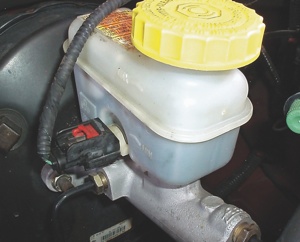
As for physical inspections, begin with the fluid level. Since disc brake pad wear is compensated for by extending the caliper piston, a low brake fluid level is a good indicator of worn brake pads. Low fluid levels are also indicators of external leakage in calipers, cylinders, metal lines and rubber hoses. If no external leakage is apparent, loosen the master cylinder from its mount on the vacuum booster and inspect it for leakage at the master cylinder rear seal. In some cases, you might discover that the brake booster is filled with brake fluid, which indicates that the booster should be replaced.
Fluid condition is also a good indicator of brake hydraulic system condition. While a light coat of residue in the master cylinder reservoir is normal, a heavy coating of sludge might indicate that the fluid is contaminated with water condensation or oil.
A brake fluid test strip will indicate excessive moisture, which can be corrected by thoroughly flushing the brake system.
In contrast, oil will generally feel more viscous than brake fluid. If oil is present, the rubber seals on the master cylinder reservoir cap or cover will be swollen and wrinkled. Oil contamination can only be corrected by replacing all rubber parts and thoroughly flushing the brake hydraulic system (Photo 5). 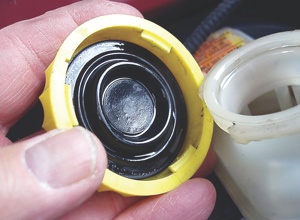
Hose and Line Inspection
Start the engine and turn the vehicle’s front wheels to full lock. Inspect the brake hoses for cuts, cracking and swelling. Remember that brake hoses tend to crack around the metal sleeve that seals the hose to the metal fitting. In addition, check the hose itself for flexibility and correct placement. The hose should never contact any chassis or suspension component throughout the normal range of steering and suspension travel. The hose should also remain loose when the suspension is fully extended (Photo 6).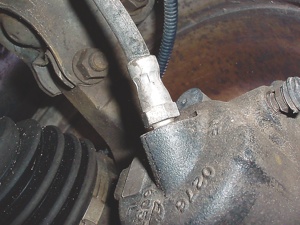
Next, inspect all metal brake lines for rust damage, particularly where metal clips attach the lines to the chassis and where the placement of the line exposes it to road salt and moisture. In many cases, the ferrule nut at the wheel cylinder or brake hose will be rusted to the line. In these cases, the line itself should be replaced (Photo 7).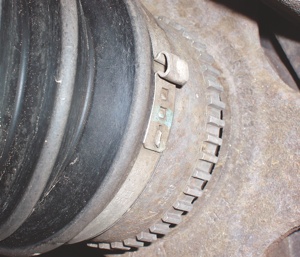
While inspecting brake hoses and lines, check for fluid leakage at the disc brake calipers and at the brake drum backing plates. In some cases, oil leaking from drive axle oil seals will cause similar signs of leakage. Oil or fluid leaking onto brake friction causes the brake to lock up. If oil or fluid contamination is present on brake friction, the friction must be replaced.
Performance Evaluation
When we road test a brake performance complaint, we must always be aware that we’re driving a potentially unsafe vehicle. For that reason, always begin by checking the master cylinder reservoir fluid level and testing the brake pedal height.
For example, a low pedal might indicate poorly adjusted rear service or park brakes. It might also indicate that the disc brakes have a loose wheel bearing or that the disc rotor is catastrophically worn.
Similarly, always check the holding power of the parking brake. If the pedal or lever exhibits excess travel or are hard to engage, the parking brakes need adjustment or replacement (Photo 8). 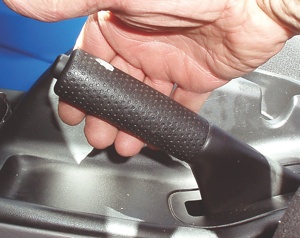
If the brake pedal sinks when the brakes are suddenly applied at rest, the cause could be a leak in the brake hydraulics. Never assume that a full master cylinder reservoir indicates a sound hydraulic system.
Jamming on the brake pedal will tend to conceal, rather than reveal, a worn master cylinder. So, if we’re investigating an intermittent sinking brake pedal, begin by gradually applying light pedal pressure to the pedal. If the master cylinder cups are severely worn, the pedal will gradually sink to the floor.
If the brakes lock up after a hard application, the master cylinder piston isn’t returning to a seated position in the cylinder bore and re- leasing fluid pressure. In some cases, the brake booster pushrod might be too long or, in other cases, the brake light switch mounted on the brake pedal might need adjustment (Photo 9)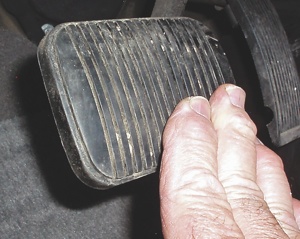 .
.
Last, a short test-drive or stopping sequence around the parking lot will usually reveal most catastrophic hydraulic, mechanical or friction failures. If a master cylinder failure is suspected, it’s always best to recommend replacement accompanied by a thorough flushing of the hydraulic system using the OEM-specified brake fluid.
During any inspection or service, always perform a complete “bumper-to-bumper” inspection of the brake hydraulic and friction systems. Whatever the case, it’s always better to be safe than sorry.













